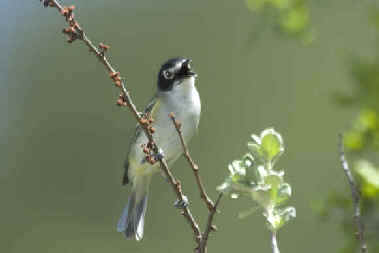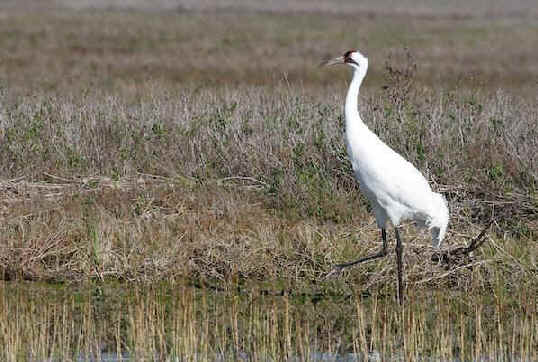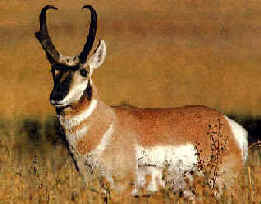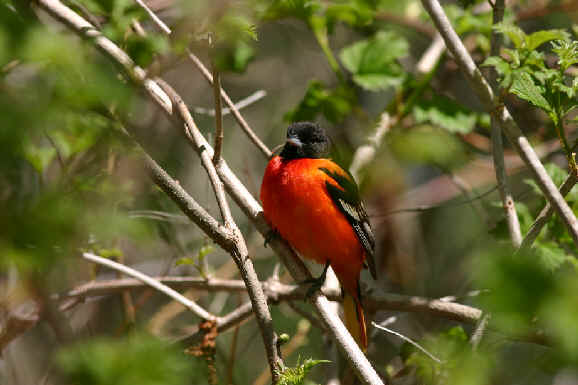
E-mail: font@focusonnature.com
Phone: Toll-free in USA 1-888-721-3555
or 302/529-1876
 |
PO Box 9021,
Wilmington, DE 19809, USA E-mail: font@focusonnature.com Phone: Toll-free in USA 1-888-721-3555 or 302/529-1876 |
Highlights
FROM PREVIOUS
FOCUS ON NATURE TOURS
in Texas
& nearby
New Mexico

Black-capped
Vireo
The
following summaries here are with the most-recent tours first.
For some tours there are links below for longer narratives. Also there are links
to UPCOMING TOUR ITINERARIES, and lists of BIRDS, MAMMALS, and OTHER NATURE.
Some previous Tours:
March 2014
May
2010 April-May
2005 April-May
2004
Links:
Upcoming FONT FONT Birding & Nature Tours in Texas
A List & Photo Gallery of Texas Birds, in 2 parts
Birds during FONT Tours in
west Texas & nearby New Mexico
Lists & Photo Galleries of: Texas Mammals
Texas Butterflies
Texas Dragonflies & Damselflies Texas Reptiles & Amphibians
Plants
of the Desert & Some Nearby Habitats (with
some photos)
![]()
TEXAS - March 2014

One of the endangered Whooping Cranes
at the Aransas Refuge
(photo by Marc Felber)
Our tour in March
2014, in central and southern Texas,
was scheduled for us to see two special and rare birds, both categorized as endangered, the Whooping Crane and the Golden-cheeked Warbler.
And that we did.
We enjoyed a fine, and close look at a pair of Whooping Cranes during the
first full day of the tour, at the Aransas National
Wildlife Refuge, along the Gulf Coast,
where what has been the only wild flock of them has wintered for years.
Our encounter with the Golden-cheeked Warbler was in the "Hill
Country" of Texas, where we saw and heard them, during the last
full day of our tour, and the first day when the species was found there in
2014, at the Lost Maples Natural Area, a
prime place for that specialty bird that only breeds in that region of central
Texas.
It spends its non-breeding season south of the US-Mexico border, mostly in
Central America. We've seen it during FONT tours in Guatemala and Honduras,
mostly in Honduras.
Another "good bird" for us in the "HIll
Country" of central Texas was a Hutton's Vireo. We
watched it sing. That species is most often seen and heard in Texas further west
in the Trans-Pecos region.
During the days between our first and last full-days of the tour, we saw a
number of other birds that were good to see, including: Green Jay, Audubon's
Oriole, Pyrrhuloxia, Greater Roadrunner, Vermilion Flycatcher, Verdin, Great
Kiskadee, Rufous-crowned Sparrow, and Harris' Sparrow, just to name a
few.
We also enjoyed seeing Sandhill Cranes, Roseate Spoonbills, Northern Crested
Caracaras, and an Aplomado Falcon.
"New" for FONT tours in Texas were: American Golden Plover,
White-winged Scoter, and Lesser Black-backed Gull.
At the end of the March 2014 Texas Tour,
our cumulative list of birds found during FONT tours in that state topped 400
species.
Also, when in Texas, in addition to the birds and other nature, we also had
some very nice times with people, at the various places we went, but especially
one evening when we had a joint-dinner with participants who were on a previous
FONT tour a few years back. That evening was when we were with a number of the
people of the Wimberley Bird Society who
were on the FONT tour in Iceland in June
2009. It was great to be with them.
Others with us in Texas in March
2014 were previously with FONT on tours in Alaska,
Spain, the Canary Islands, Guatemala,
and another Iceland tour.
Links:
More
about the FONT Tour in Texas in March 2014
Birds
& Other Wildlife during our Texas Tour in March 2014
![]()
TEXAS - May 2010
Our tour in the big state of Texas
in May 2010 was in the south-central part of
the state, from the Gulf Coast to the Hill
Country.
In that area, we met with a nice array of birds, including, along the
coast, Piping Plover and Black Rail. Eastern migrants were seen as
well, including warblers of various kinds in small trees by the salt
marsh and sand dunes. A small tree there was filled with orioles during
their migration.
In the Austin area, for birds, "east
meets west". From the city east: Ruby-throated Hummingbird, Blue Jay,
and Red-bellied Woodpecker. From the city west: Black-chinned
Hummingbird, Western Scrub Jay, and Golden-fronted Woodpecker. Of
course, from Austin west, in the "Hill
Country" of the Edwards Plateau,
there are the two special birds of the region, the Golden-cheeked Warbler,
and the Black-capped Vireo. The Golden-cheeked Warbler only
nests in Texas; the Black-capped Vireo nearly so.
Among the mammals during the tour were the thousands upon thousands of Mexican
Free-tailed Bats that fly at dusk from caves and even a city bridge. Other
mammals included: Gray Fox, Wild Boar (that has become established in
some wild parts of Texas), Black-tailed Jackrabbit, and raccoon,
deer, and opossum. Other wildlife included: American Alligator,
and various turtles and snakes. Wildflowers were absolutely
in profusion. Butterflies were plentiful.
Links:
More
about the FONT Tour in Texas in May 2010
Birds
& Other Wildlife during our Texas Tour in May 2010
![]()
ACROSS TEXAS -
April/May 2005
During this tour we traveled
across the big state of Texas, with its many birds (the most birds of any US state, of course - it's
Texas!). We began by the Gulf of Mexico and went all the west to Big
Bend National Park and El Paso.
In all, 266 species of birds were found during the tour, with good flights of
migrating warblers and other birds by the Gulf, and the Colima Warbler
as other specialties in the Chisos Mountains at Big Bend.
In between we had wonderful looks at the two foremost avian specialties of
Texas: the Golden-cheeked Warbler and the Black-capped Vireo.

"A Tour
Across the State
from the Gulf to the Desert"
The following account written
by Armas Hill, leader of the tour:
During this tour, April 26 - May 9, 2005, we
traveled across the large state of Texas,
birding as we went, from the Gulf Coast west to Big
Bend National Park and El Paso.
Much of our travel paralleled the
course of the Rio Grande, the river that's the boundary between the US &
Mexico.
Birding near that river, particularly in far-southern
Texas, produced some birds that are normally more Mexican than Texan.
These included: Gray-crowned Yellowthroat, Tropical Parula, Clay-colored
Robin, Blue Bunting, Green Jay, Green Kingfisher, Green Parakeet, Red-crowned
Parrot, Couch's Kingbird, Great Kiskadee, White-tipped Dove, Buff-bellied
Hummingbird, Altamira Oriole, Groove-billed Ani, and Plain Chachalaca.
By the Rio Grande in western Texas, at Big
Bend, another species more Mexican than Texan, that we saw, was the Tropical
Kingbird. And yet another, the Gray Hawk was nesting in a tree
nearby.
Areas away from the Rio Grande that we visited included places along the the
Gulf Coast such as Rockport, Aransas, and Padre
Island, and the "Hill Country" of
the Edwards Plateau. Each of these areas produced a number of our
desired birds.
In all, 266 species of birds were found during our tour across Texas.
Even though we traveled a good number of miles, from Corpus Christi to El Paso,
we actually only covered, as we found those 250-plus bird species, but a portion
of the very big state. Yes, Texas is BIG - as big as it gets in the "Lower
48".
Among our prime avian objectives in the big state of Texas were what we called
the "Big 4", even though they were not big at all. The largest of them
is just over 5 inches in length. That's the Colima Warbler. The other 3
of the "Big 4" targets were the Golden-cheeked Warbler,
Black-capped Vireo, and Lucifer Hummingbird. We saw them all.
These birds are prime objectives in Texas because mostly they are found in no
other state. One of them, the Lucifer Hummingbird, it should be noted,
does occur uncommonly in Arizona in the summer. Actually, the only place where
that species is common is Mexico. Some years in the US, its numbers are less
than in others, even where it's regular. We found at Big Bend in '05 the Lucifer
Hummingbird to be less common than it was in '04. But a male, observed one
afternoon, was a good sight.
The other 3 of the "Big 4" were seen very well during our '05 Texas
tour.
All of the "Big 4" winter in Mexico (1 of them, the Golden-cheeked
Warbler, also further south into Guatemala).
The Golden-cheeked Warbler nests only in Texas. We observed some males
nicely in the "Hill Country" of the Edwards Plateau. The
Golden-cheeked Warbler is classified by Birdlife International as
"Endangered". In the "Lower 48" states of the US only 4
species are so classified. 2 of the others are the Whooping Crane (that
winters in Texas) and the Gunnison Sage-Grouse. The other, the Thick-billed
Parrot, is really a Mexican species. It has not occurred in the US in years. It
did formerly in Arizona.
Another of our "Big 4", the Black-capped Vireo, we saw well in
the western Edwards Plateau. That species is classified as
"Vulnerable" by Birdlife International. In the US, nearly all
Black-capped Vireos nest in Texas. Only a very few do so in Oklahoma (and it
formerly did in Kansas). It also breeds in northern Mexico.
The Colima Warbler is classified as "Near-threatened" by
Birdlife International. In the US, it nests only in western Texas, at a
particular elevation and in a particular habitat in the Chisos Mountains in the
Big Bend National Park. To get where it is, a trail must be walked. We did, and
we saw and heard the bird nicely. Other than at Big Bend, the Colima Warbler is
exclusively Mexican. They breed in that country, and all of them winter there.
Some other birds more Mexican than Texan that we encountered during our Texas
tour (in addition to those already mentioned) included: Least Grebe (at
one time, we saw 7 together, 2 adults & 5 young, the least of the least),
Neotropic Cormorant, Pauraque (seen & heard at Aransas), the Mexican
(or Gray-breasted) Jay at Big Bend, the Northern
Crested-Caracara (also known as the "Mexican Eagle"),
Chihuahuan Raven (named after the Mexican state), Olive
Sparrow, White-tailed Hawk, Harris's Hawk, the Aplomado Falcon, and
the Black-bellied Whistling-Duck. Some comments are warranted, and
follow, about the last two of these species.
The Aplomado Falcon is overall not a rare bird "south of the (US-Mexican) border". In some places, such as Costa Rica, it is. In others, such as Brazil, it's quite common. In the US (Texas), it formerly occurred until the early 20th Century in southern Texas, and until the mid-20th Century in western Texas. About 15 years ago (in 1989), a reintroduction program began in south Texas. Since then, about 700 birds have been released. And the species is now breeding in southern Texas. We can confirm that as we saw a pair mating, close to us, atop a telephone pole along a road between Brownsville and the Gulf of Mexico. We also watched those two birds in flight - flying as the species once did naturally over a century ago in Texas.
The Black-bellied
Whistling-Duck about 40 years ago occurred in Texas almost exclusively in
the lower Rio Grande Valley, and south the southern Gulf Coast (south of
Corpus Christi). During the decades since, the species has expanded its
range and increased its numbers considerably. As we went across Texas, we saw
many, well to the north and west of that previous range of 40 years ago. What
was particularly interesting was how the species has adapted to living in the
town and cities, in residential areas. Often we saw the birds in flight over
neighborhoods and standing on the roofs of homes. They were notably fond of
trees, either being on stumps or high bare branches. After all, they have been
called historically "Black-bellied Tree Ducks".
Another bird that we saw to have had a major expansion through Texas, in recent
years, was the Eurasian Collared-Dove. It's common in southern and
eastern Texas, often, like the whistling-duck, in towns and cities. We saw the
Eurasian Collared-Dove as far west as one can go in Texas, in El Paso.
Yet another bird species that has increased in Texas in recent decades has been
the Cave Swallow. We saw many, especially along highways at bridges and
overpasses.
Our best spectacle for numbers of birds during the tour was during 3 days in the
area of the Gulf Coast, as many were seen on their migration north. At places
such as South Padre Island, and Goose Island, trees and bushes were sometimes
dripping with birds. Lawns and feeders also had their share. Very numerous were
the warblers, and there were other birds in good numbers such as flycatchers,
hummingbirds (Ruby-throated), kingbirds (Eastern), thrushes,
tanagers, orioles (many), waxwings (Cedar), and grosbeaks
(Rose-breasted).
Nearly 30 species of Warblers were seen during our tour. In addition to
those already mentioned here (the Golden-cheeked, Colima, Gray-crowned
Yellowthroat, & Tropical Parula), there were for us in
southern & eastern Texas, many species of eastern warblers during their
migration. Our most commonly observed species was the Black-throated Green.
But other notables, often in colorful breeding plumages, included: Blue-winged,
Golden-winged, Chestnut-sided, Magnolia, Blackburnian, Bay-breasted,
Yellow-throated, Hooded, Wilson's, Kentucky, Canada, Worm-eating, Nashville,
Tennessee (candidly not as colorful as some of the others), Ovenbird,
and Northern Waterthrush.
A good bird migration is a fascinating phenomenon. Sometimes it's subtle,
while other times it's obvious, and when it is It's one of the most exciting
experiences birders can have. We've been in the midst of such migration during
FONT tours in other parts of the world, for example, at the southern tip of
Sweden in the autumn and on a small island in the Sea of Japan in the spring.
The migration that we experienced along the Texas coast in May '05 was as good
as any, actually as good as it gets. To see so many birds, having just crossed a
portion of the Gulf of Mexico, and actively feeding in low bushes in front of us
was, yes, exciting. And it was especially so with the variety of species and so
many colorful warblers.
About a month, to the south in Central America, during our Guatemala tour, in
the area of the Mayan ruins of Tikal, some of the same birds we would see in
Texas were noted already on their way north. There were the warblers and
flycatchers, and quite memorable was a tree filled with Baltimore Orioles by one
of the temples.
During our May '05 Texas tour, migrating Orioles were seen en masse, both
Baltimore and Orchard, sometimes in flocks in flights and
memorable, again, was a tree filled with more than 15 colorful Baltimores at
once.

Even just 1 male Baltimore
Oriole is bright & colorful.
Migrating Tanagers, with
their red coloration, were both Scarlet and Summer.
Migrating Flycatchers were Great Crested and Eastern
Wood-Pewees.
Migrating Thrushes were Swainson's, Gray-cheeked, Wood, and Veery.
Incidentally, as we traveled west across Texas for 2 weeks, a thrush we never
saw was the American Robin.
What we did see with all of the migrants just-mentioned were Dickcissels.
They, as well as Scissor-tailed Flycatchers, were evident in the east
Texan countryside. Both species, for those of us from elsewhere in the Country,
were nice to be seen as often as they were.
Swainson's Hawks (both the light & the dark morphs) were also
nice to be seen, as was a flock overhead of migrating Mississippi Kites,
on their way north.
A favorite among the many birds seen during our '05 Texas tour was the Painted
Bunting. The species was seen many times & many places across the state.
No matter how many times the colorful male is seen, however, it's still a
favorite.
Seemingly a bit out a place, and off schedule, along the Texan coast of the Gulf
of Mexico, very close to Mexico, one afternoon, there was an immature Glaucous
Gull along the beach. Also along that beach, we saw a Piping Plover (a
threatened species more apt to be there in the winter) in company with Wilson's
Plover. Also there were: Red Knot, Black Skimmer, and Terns
including Sandwich, Royal, and Caspian, in addition to other
coastal birds.
Shifting from the Texan coast, to the opposite end of the state, to the desert
and some other habitats of far-western Texas, some of the birds that we enjoyed
there included: both Scaled and Gambel's Quails, both Pyrrhuloxia
and Phainopepla, both Western and Clark's Grebes on the
same lake (more of the former), a large flock of Long-billed Curlews,
spinning Wilson's Phalaropes, the Greater Roadrunner, Vermilion
Flycatcher, Common Poorwill, lots of Lesser Nighthawks, White-throated
Swifts (doing their flights that aptly could be called
"swift"), Canyon Wren (with its beautiful song),
Varied Bunting, and Crissal Thrasher.
Of all the birds we encountered during our 14 days in Texas, there was only one
that got on our check-list every day. It was in the thrasher group. It's
actually the state bird of Texas, occurring in an assortment of habitats
throughout the state. We saw many, of course, and it could be said that we heard
many more, by day and by night. It was rare for a Northern Mockingbird
not to be heard, at any given time, somewhere near us.
The state bird of Texas, the Mockingbird, is one of about 625 species of
birds that have been recorded in the state. That's more than in any other US
state. There are so many species of birds in Texas that it was the only state
which had its own Peterson Field Guide.
We've seen many of the birds recorded in Texas during our tours there (nearly
half). But, with more yet to be seen, there will, of course, be future FONT
tours, for birds (& butterflies, and other nature) in Texas!
Links:
Birds and Other Wildlife during the FONT Texas Tour - April/May 2005
![]()
TEXAS &
NEARBY NEW MEXICO - APRIL/MAY 2004
"Pronghorns &
Longhorns; the Colima & a Ringtail"
The following account written by Armas Hill, leader of the tour:
During our tour in west Texas and nearby New Mexico, April 25 to May 3, 2004, Pronghorns and Longhorns were among the creatures seen.
Actually, there were many more Pronghorns, the graceful and attractive wild antelopes of the American West. They can move at considerable speed.
Not moving much at all, were the fascinating Longhorn Cattle that were seen. We didn't see many, but they were a sight out on the rather barren land by the Chihuahuan Desert.
The Chihuahuan Desert is the largest desert in North America. There had been some rains prior to our visit, and the plants were blooming. Flowers, some yellow, white, red, and other colors, were amopng the agave, prickly pear and other cacti, cholias, ocotillo, lechuguilla, acacia, yucca, and candelilla. Yes, the desert was a nice place to be, and we were there at a good time.
Our tour in Texas was in the
area known as the "Trans-Pecos" -
that is generally the 10% or so of the huge state west of the Pecos River.
Pecos, by the way, is one of the
west Texan towns through which we traveled. It was, at one time, a rough
frontier town. Today, times there seem a bit rough.
To give an idea of what it's like around Pecos, let's note that north of there,
along the main highway, is a town with a population of 20, that is the only
town in the least populated county in the Lower 48 States. (The
county population fluctuates, but it's about 110. There are more Turkey
Vultures in the county than
there are people.)
We traveled in this region of desert, former frontier towns, pronghorns and longhorns, actually to see birds, and other wildlife. And that we did, with 145 species of birds, along with a nice assortment of animals.
In western Texas, 3 particular regions that we visited to see birds and other nature were the Guadalupe Mountains (the highest in Texas), the more-rolling Davis Mountains, and the various habitats of Big Bend National Park including the Chisos Mountains.
In nearby New
Mexico, we visited an array of habitats in a relatively small area
(by "Western standards") near Carlsbad
Caverns, where the caves are known for their bats.
A
target-bird of that region is the Cave Swallow, which was actually
nesting outside the door of one of our overnight accommodations. As we slept
inside, the swallows were doing so outside.
Other birds that we saw in that region of
New Mexico included:
Scissor-tailed Flycatcher,
in an agricultural area (about as
far west as the species regularly occurs),
Varied Buntings,
a pair of them that appeared to be nesting in the mountains,
a Golden Eagle, circling
overhead above a mountain butte,
Common Poorwills,
at dusk, sitting on dirt roads, and adding to the sounds at dusk,
Lesser Nighthawks,
many of them together, after dark, catching insects by lights along a road.
By day, Black-chinned
Hummingbirds were seen on their nests,
Canyon Wrens
were both seen and heard, with their songs echoing from cliff-sides,
and Cactus Wrens were ubiquitous.
Phainopepla
and Pyrrhuloxia were seen (easier
to see than to say).
At one place with green trees and a springs, surrounded by habitats with brown, we saw red - lots of red, with numerous Cardinals, Summer Tanagers, House Finches, and Vermilion Flycatchers (for a red bird, the adult male is about as good as it gets).
We also, in New Mexico, saw our share of yellow in the Yellow-breasted Chat, Yellow Warbler, Yellow-headed Blackbird, and Scott's Oriole. Our glimpse at the yellow of a MacGillivray's Warbler was a bit quicker.
Not just Inca Doves, but now Eurasian Collared-Dove is in the Carlsbad area.
For a tour mostly in Texas, as just noted, our New Mexico birding was not at all bad.
But there were a number of birds that, of course, we saw in Texas, and among them were quite a few only seen there
One of the primary avian-targets of a
west Texas tour is the Colima Warbler. The species only occurs in the
United States in the Chisos Mountains in Big Bend National Park in Texas.
Otherwise it is Mexican.
We had a wonderful encounter with this targeted-bird.
After walking a couple hours up a mountain trail, being "trailed"
ourselves by tame and seemingly-hungry Mexican Jays (how could they be
that hungry?), we were in a beautiful area with a comfortable temperature.
It was there where we enjoyed the sight and sound of the Colima, not far
in front of us, singing as it sat on a bare branch atop an oak tree.
As we were watching the warbler, we saw that we in turn were being watched. Also in front of us, in some large rocks beneath the oaks, there was first a head, and then an entire animal. It was close, and it was curious. It was a Ringtail, an animal somewhat similar to a Raccoon, but slimmer, with a long, bushy, striped tail. According to "the book", the Ringtail is "strictly nocturnal". That Ringtail did not read the book.
Those of us who went further up the mountain trail, encountered a singing Painted Redstart, another warbler most-often in Mexico.
Another bird more apt to be in Mexico than the US, and another prime avian-target of our tour was the Lucifer Hummingbird. It's another specialty of the Big Bend area, where we saw it nicely in an area of desert with flowering plants. Undoubtedly attracted to those agave stalks, male Lucifer Hummingbirds sat in good view for us to see (in a scope). The small hummingbird with a long bill, long tail, and a wonderful purple gorget, was quite a sight. Nice to see, as well, was a male doing its aerial display flight.
Some other birds in that area, also seen, but so much in the open were the Crissal Thrasher and Gray Vireo. A pair of Verdins were nicely seen at their nest.
Notable among the raptors that we saw in the Trans-Pecos region of west Texas, were Common Black Hawk in the Davis Mountains, and Harris's Hawk in the Rio Grande Valley.
Particularly enjoyed in the Chihuahuan Desert (either in the Rio Grande Valley and/or elsewhere) were some birds that stayed close to the ground Roadrunners (we have some great looks) and both Gambel's and Scaled Quail.
In the open country of the Davis Mountains, there were Bluebirds. Mostly Western Bluebirds, but also Mountain Bluebird (a lingerer from the winter).
In the town of Fort Davis, feeders at a small lot attracted birds. At the hummingbird feeders, there were Black-chinned Hummers, both males and females. At the feeders with seeds, there were a number of Goldfinches, both Lesser and American.
In small trees and bushes of the Guadalupe Mountains, birds included Red-naped Sapsucker (apparently another lingerer from the winter), and Western Tanager and Townsend's Solitaire (these apparently resting during their migration).
Also migrating were some birds
we saw in areas of open water near Pecos. Notable among them, and quite
attractive, were many Wilson's Phalaropes. Also attractive, in their
breeding attire, were American Avocets.
Nice to see, and somewhat unexpected, were Least Terns.
Thus, a summary of some of the birds we saw in West Texas and New Mexico, during our Spring '04 tour.
However, it was not only birds, and some animals, and flowers, that we saw during the tour. It was also an area with some very spectacular scenery of the Southwestern US.
In that area, one could stand and look, and with an imagination, and having read a bit about what was there historically, the mind could revert to other days there a long time ago. That's the way I'll now end this narrative
Today, it's birds that fly in the skies of west Texas. And bats and insects also. However, in days now long gone, as many as millions of years ago, in those skies of Big Bend and nearby, there were other creatures that flew.
If we'd been able to have
observed them, to us they would have been astounding. They were Pterosaurs,
or flying reptiles, in the Age of Dinosaurs.
Birds, it's commonly accepted, are said to have evolved from reptiles in that
age.
The largest animal now known to have ever flown under its own power did
so in the skies of what's now west Texas. It had a wing-span was nearly 40 feet. The
name given to that amazing creature, that once was, is Quetzalcoatlus
northropi. It is named after a feathered serpent Aztec god. (Today,
further south in the Americas, from Mexico to Panama, there's a living bird also
named after that god. That bird, the Resplendent Quetzal,
has been called the most beautiful bird in the world.)
But referring again to Quetzalcoatlus:
That incredible creature has only become known to science rather recently. The
first specimen of it was found in the early 1970s. It was part of a wing. Since
that initial specimen was found, a number of smaller individuals have also been
discovered, about 25 miles from where the first specimen was obtained. These
specimens in combination give a fairly good idea of what Quetzalcoatlus was
like. All of the specimens are from the end of the Cretaceous Period (of the
Mesozoic Era), about 66 million years ago.
Pterosaurs, such as Quetzalcoatus,
died out near the time of the extinction of the dinosaurs. Thus it was that
those flying dinosaurs, like Quetzalcoatus, and smaller ones (as small as
sparrows), actually overlapped with birds for about half the time they
existed.
Such are fascinating thoughts
that one can have, about creatures that once were, in western Texas skies, as we
look for and observe birds in that area today.
Yes, fascinating it is. It can
make our imaginations run wild regarding the flying dinosaurs, once there, as
small as sparrows, and as large as Quetzalcoatus northropi, a giant with
a 40-foot wing-span, that's now known as the largest creature that's ever flown.
Links:
Birds and Other Wildlife during FONT tours in west Texas & New Mexico
Upcoming FONT Birding & Nature Tours in Texas